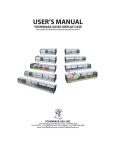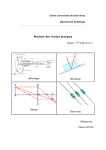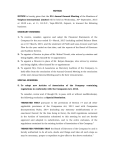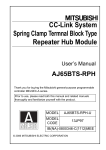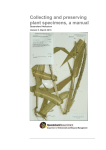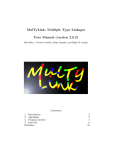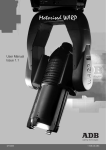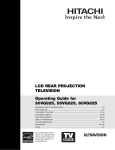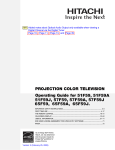Download Reflected signal - TV antenna installation guidelines
Transcript
Alexander Serov TV antenna installation guidelines or how to become a good signal hunter Phnom Penh, Cambodia, 2015 Hello, my Cambodian friends! My name is Alexander Serov. I’m a Russian engineer with 20-year experience in radio and television technologies. I have written this book to help you to install a television antenna in your house. This book can be a good guideline if you want to run your own installation business too and to help other people to have the best TV quality at home. This book is a non-profitable project. Anyone can use the whole book or any part of the book for any purposes. I wish you good signal hunting! 25.07.2015, Phnom Penh 1 Steps of installation of an antenna 1 Prepare and check your instruments and materials 2 Choose the side of a house where it is better to install 3 Install an antenna, connect it to a set-top-box 4 Check the signal and adjust the antenna 5 If the signal is bad, change the orientation or the place of the antenna 6 If the signal is good, you have finished. 2 What you need Installation is a very simple proccess. You don’t need to have many instruments with you. Pliers. You need the pliers to screw nuts, bend a metal wire and cut cables and tiers. Plastic tiers. You need them to fix cables and rods. It is a good idea to have tiers of different colors and length. A metal wire. You need it to fix cables and rods in places where you can’t use tiers. An electrical tape. You need it to isolate connectors of antenna. 3 What you need An antenna. Use only antennas recommended by specialists. RG6 cable with connectors 10-20 meters long is usually enough for one installation. Use thick bamboo rods or metal rods 1.5-2m for a balcony and a roof installation (don’t use thin bamboo!) If you need long bamboo rods, you may ask the client to prepare them for you. And, of course, you need a set-top-box! 4 Don’t use antennas like this These two antennas are good only if you are very close to a transmitter tower (no more than 1 km) and conditions are good. This is an antenna for cars. You can’t receive good TV signal with this antenna unless there is a special transmitter in your city. This antenna is for vertical polarized signals. You can’t receive a good signal with an antenna like this. 5 Don’t use antennas like this All these antennas are good looking, but they will be working badly. These antennas are for indoor use only. You can use these antennas only if the signal is very good and the conditions are good too. 6 Don’t use antennas like this This antenna can cost much money. This antenna will not work for a long time. This antenna is not good because birds can make nests inside it. The antenna on this photo is not working because of the nest 7 I recommend antennas like this I tested many types of antennas and found that these designs showed the best results. You can try different antennas yourself and find the best for you! 8 Big antenna This antenna is big. Use big antennas only if the distance to the transmitter is big (more than 20km). This antenna will work badly if the distance to the transmitter is small. 9 Small and medium antennas These antennas are medium. You can use these antennas if the distance to the transmitter is medium (520km) Don’t use these antennas without a booster if the distance to the transmitter is very long. These antennas can work badly if the distance to the transmitter is less than 5km This antenna is small. Use a small antenna if the distance to the transmitter is less than 35km 10 An antenna is like an eye An antenna is like an eye. A signal is like light. A TV tower is like a lamp. But this light is invisible for human eyes. An antenna is an electronic eye for an invisible TV signal. Any antenna must see a signal. If an antenna sees no signal, a set-top-box or a TV-set can’t work. 11 Direct signal A TV signal can be DIRECT or REFLECTED. A TV signal is DIRECT when an antenna sees a TV tower and there are no big buildings between the antenna and the TV tower. This antenna sees a DIRECT signal The TV tower 12 Reflected signal A TV signal can be reflected from walls, building and trees like light is reflected by a mirror. This signal is called a REFLECTED signal. Not every building, wall or tree can give a good reflected signal. High house Wall This antenna sees a REFLECTED signal from the wall 13 How to point an antenna An antenna is like an eye. This eye needs to see light. You need to point an antenna to a TV tower or to a reflected signal. An antenna has the front end and the rear end. The front end MUST be pointed to a TV tower or to a reflected signal. In this case the antenna will see signal like an eye sees light. This is the front end of the antenna. You point it to a TV tower or to a reflected signal. This is the rear end of the antenna. You use it to mount an antenna on a thick bamboo rod, a metal pole etc. Don’t make your STB blind! Getting more signal is not always good. If an antenna is big and a TV tower is close, a STB can’t work properly because it gets blind. It gets blind like a human eye gets blind from strong light. If the signal is strong, use medium or small antennas. 14 What is the best place for an antenna? Part 1 ? ? ? ? ? ? ? ? The best place on a house for an antenna: 1. Place an antenna as high as possible. Install an antenna on a roof with a thick bamboo pole if possible. 2. Place an antenna on the side from which you can see a TV tower. 3. Place an antenna on the side from which you probably have a REFLECTED signal. Not always you can easily understand which side is the best. Sometimes you have to try several different places to get a good signal! 15 What is the best place for an antenna? Part 2 At first you need to choose the right side of a building, where to place an antenna. The best side is the side in the direction of a TV tower. You can place an antenna on the best side and point the antenna to a TV tower. We see it from above! TV tower House This side is the best for an antenna We see it from above! TV tower House These sides are the best for an antenna Here are tall buildings, trees, towers. They can give a REFLECTED signal. If the client lives not in the best side of a house, you can place an antenna on any side and point the antenna to the nearest tall building, wall, tree or tower. The nearest tall building, wall, tree or tower can give a REFLECTED signal. We see it from above! TV tower House Where does a reflected signal come from? 16 If you don’t see a TV tower and can’t get a good signal from the direction of a TV tower, try to get a REFLECTED signal! A row of buildings in a street. Try to point an antenna to front of the buildings. A big building (like the Vattanac building). A big building gives a good reflected signal. Try to point an antenna to high buildings. A big wall or a roof. Try to point an antenna to big walls or to a roof of houses near the antenna. A big tree. A big tree gives not a good reflected signal, but you can try. Example of how to point an antenna to a TV tower This antenna is pointed in the best possible way – directly to the TV tower (in this example the TV tower is the CTN tower in Phnom Penh) 17 Example of how to point an antenna to a TV tower The TV tower is in this direction, but you can’t see it. If you can’t see the TV tower, but you know where it is – point an antenna in that direction first. It is very important to find the direction of a TV tower. Use your knowledge of the land to find the direction of a TV tower! You can use Google Map or Open Street Map. 18 Example of how to point an antenna to the nearest tall building This antenna is pointed to the nearest tall building. This building can give a REFLECTED signal. This method is not 100% good. If you don’t have a good signal, try other possibilities. 19 Example of how to point an antenna to the Vattanac skyscraper If you live in Phnom Penh, try to point an antenna to the Vattanac skyscraper. The Vattanac skyscraper is tall and can give a REFLECTED signal. 20 Example of how to point an antenna to the nearest house These antennas are pointed to the nearest houses. This method is not 100% good. If you don’t have a good signal, try other possibilities. 21 Example of how to point an antenna to a wall You can point an antenna to a big open wall. A wall is like a mirror for a signal. A wall can give a REFLECTED signal. This method is not 100% good. If you don’t have a good signal, try other possibilities. 22 How to mount an antenna on a balcony The best place for an antenna is a balcony or a roof. You can install an antenna on a wall if you have a special mount. If you can install an antenna on a balcony, fix it on a vertical balcony rod. This is an example to give you the idea how to do. To TV station or to reflected signal Fix the cable to the antenna by a This is a cable to a TVsticky tape and make a cover of the set. connector by the same tape. It will help to protect the connector against rains. Please notice that the antenna is horizontal. It is parallel to the ground. This antenna doesn’t point to the ground. This antenna doesn’t point to the sky. 23 How to mount an antenna on a balcony (another example) This is another example of how to mount an antenna on a balcony. A thick and short bamboo rod is used. This rod is tied to a vertical bar of the balcony by plastic tiers. To TV station or to reflected signal This rod is tied by plastic tiers in two places 24 How to mount an antenna on a balcony ( one more example) What to do if a balcony has no vertical bar? This example can explain! This is the idea! To TV station or to reflected signal Use two plastic tiers criss-cross. You can use a metal wire too. 25 26 How to mount an antenna You can install an antenna on a roof on a long rod. You can use a thick bamboo rod or several bamboo rods together. Don’t use a thin bamboo, because it will bend in wind and rain. Fix the cable to the bamboo rod by a sticky tape and make isolation of the connector against rain by the same tape! To TV station or to a reflected signal (in PARALLEL to the ground, not to the ground, not to the sky!) Thick bamboo rod (don’t use thin bamboo!) This is the roof of the house Fix this bamboo rod to the house by a metal wire. If you don’t fix it, the bamboo rod will fall in wind and rain. A metal rod is better than a thick bamboo rod. A plastic water tube is worse than a bamboo rod, don’t use plastic tubes to install antennas! 27 You have to isolate a connector This antenna is installed on a thick bamboo rod tied to the balcony. This antenna is pointed to a TV tower directly. The connector is isolated against rain by a sticky tape. You have to tie the cable to a bamboo rod This antenna is installed on a thick bamboo rod tied to the balcony. This antenna is pointed to a TV tower directly. This cable is tied to the bamboo rod by a plastic tier. You can use a sticky tape too, but a plastic tier is better. You can put a sticky tape on the cable in the place where the tier is installed. It protects the cable. 28 29 How to tie a rod to a vertical bar of a balcony or a house This thick bamboo rod is tied to a vertical bar of the balcony. You have to tie the bamboo rod in several places not only in one! The rod on the picture is tied two times: in the upper part and in the lower part. The upper tier The lower tier 30 An example of a clamp Different types of antennas can have different clamps. On this picture you can see an example of a clamp. Don’t install the clamp too close to the end of a thick bamboo rod. A strong rod made of three bamboos (example) If you need to make a long rod, use three bamboos, not one. Here are three bamboo rods tied together. They have made one strong rod. Tie a rod to a vertical bar of a balcony or a house in several places. 31 How you should NOT install antennas (bad examples) These antennas are not horizontal, not parallel to the ground. They see the ground, not a signal. Signal 32 How you should NOT install antennas (bad examples) Any antenna must be installed toward an opened space. These antennas are installed in an closed space where the signal is bad. 33 34 How to handle the cable Keep in mind these simple rules: 1. RG6 is a fragile cable, don’t bend it like this: 2. Use small plastic tiers to fix the cable to a rod and to a house 3. Don’t leave the cable hanging freely in the air. If you need to route a cable between buildings, use a wire and attach the cable to the wire. This is the F-connector. It is from an antenna’s end of the cable. This is the IEC-connector. It is from an set-top-box’s end of the cable. 35 What to do after installation After the installation you need: 1. Connect the antenna to the set-top-box (STB). 2. Press the MENU button on the remote control unit. 3. Choose SETUP (the name of the item may be different) 4. Choose MANUAL TUNING (the name of the item may be different) 5. Check the level of the signal on the frequency of the signal (for example, OneTV in Cambodia uses channels 51-55). 6. If the level is not good, you need to adjust the antenna or to install it in another place. Please look into the user manual of the set-topbox to understand how to tune this set-top-box. The level is good if the level indicator is above 70% The level is good if the quality indicator is above 70% If an STB has an SNR indicator (signal-tonoise ratio), the level is good if the SNR is greater than 20-24dB If you don’t know the numbers of channels or frequencies of a signal, use an automatic tuning mode in the set-top-box That is all that I wanted to say about installation of antennas. I wish you great success in installation business and in the hunting for a good TV signal! Alexander Serov ([email protected]) Thanks to: Phourng Putthik Edwin Pareja Hong Pharin Sean Michael Pareja Special thanks to: Mr. Ouk Vora Editor: Olga Kislinskaya







































